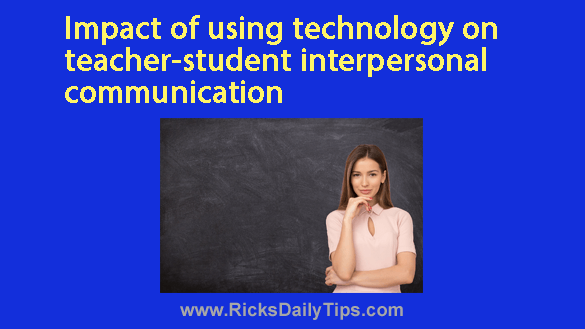 You might have heard teachers talk about one class being better than the other. Have you ever thought about why it’s so?
You might have heard teachers talk about one class being better than the other. Have you ever thought about why it’s so?
The answer is simple. Great teacher-student interpersonal communication. Interpersonal communication is exchanging information and ideas between two or more individuals.
This could be through verbal or non-verbal methods. In every class, there is a face-to-face exchange of information. This could be through voice, body language, or gestures. Your communication skills determine how well students will understand the intended message. And this is the goal of every teacher.
Why teacher-student communication is important
Great interpersonal communication between teachers and students are very vital. That’s what determines how quickly the students will understand different concepts. Every concept taught should reach the students without any barriers. So, what should you do if your students are unresponsive? Improve how you deliver your content.
Not every student in the class is equally brilliant in the class. This is why how you communicate with the students’ matters. Do you often get answers from particular students?
If so, the earlier you work on your interpersonal communication skills, the better. Learn more about teacher-student interpersonal communication. You can get help with an essay on interpersonal communication on StudyMoose. The essays are written by academic experts with in-depth knowledge of the subject. The essay and research paper samples will help you understand its benefits in class.
Great teacher-student interpersonal communication keeps the class lively. As a result, there is a deeper understanding of the concepts being taught. There is no two-way communication if you ask questions and get no response.
Probably, the students are bored due to your teaching approach. Active involvement in learning adds interest. It gives students better points of view on what they are learning. This helps the teachers get feedback quickly from the students.
To improve your teacher-student interpersonal communication skills, technology is key. With technology, you can create a more personalized learning environment that caters to all students. Integration of technology in learning allows the students to learn at their own pace. That said, let’s dive into how technology improves teacher-student interpersonal communication.
Access to educational resources
Students who don’t understand clearly what you are teaching will rarely ask questions. It’s hard to frame a question for a concept you don’t fully understand. Sometimes you will ask the students whether they have understood, and most will say yes. It’s normal for the students to think they understand when they don’t.
With technology, students have access to educational resources. These resources are in the form of text or video. If you teach challenging concepts, send the notes to the students and ask them to open them in class. You can also ask them to browse for notes related to the topic on the internet.
At the end of the class, even slow learners will understand the basics. They will ask for clarification where they don’t understand clearly. This facilitates two-way communication whenever you ask questions, as the students will respond as per their understanding.
Simulation of experiments
Demonstrations are vital for every experiment. They help students understand how different models work. This is the only way you will be sure that the students understand the working of the different models connected together.
Though, only a few experiments can be performed in the lab with great precision. Some reactions are very poisonous. Others require extreme conditions. So, how does technology help teachers achieve their targets?
With technology, teachers can simulate any experiment they want. There are great visual aids that help teachers illustrate different reactions. In addition, teachers can take students on virtual tours of the places of their interest. This reinforces learning and improves teacher-student interpersonal communication. That’s because students will understand things that were impossible to capture without simulation.
Increases communication
One of the positive effects of technology in communication in the classroom is that it increases collaboration. Students can communicate with teachers via email or social media platforms.
Whenever students have challenges understanding a particular concept, they can post it to the class group. That’s during online classes. Then, the teacher will note it and discuss it later or during physical class.
Currently, teachers can post results on the students’ portal without displaying them publicly on the noticeboard. Marks can be entered directly into the portal and then computed. This makes it easy for the students to track their progress at any time they want.
Those that perform well will be motivated to put in more effort. This will ultimately increase their engagement in class. Afterward, teachers can follow up with the others and seek to understand their challenges.
Conclusion
How we interact with others using technology in learning helps them learn better. Technology has improved interpersonal communication in class. It’s possible to personalize learning and do a follow-up on underperforming students. It’s possible to simulate lots of experiments. Don’t bore the students with hours of lecture. Instead, let them be part of the discussion.